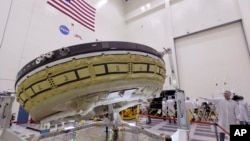Earthlings have long fantasized about flying saucers from Mars, but in a strange twist, it may be humans that end up launching one to the Red Planet.
Early this month, the U.S. space agency NASA will test what it calls the Low Density Supersonic Decelerator mission, or LDSD. The test will take place high in the Earth’s atmosphere, at altitudes that most resembles the thin Martian atmosphere.
The saucer shaped craft could be the key to future exploration of Mars as it would allow heavier payloads to be delivered to our planetary neighbor.
“Future robotic missions to Mars and even future human exploration will require more massive payloads than previously sent to the surface of the Red Planet,” NASA said in a statement.
The inspiration for the LDSD came, oddly enough, from a sea creature, the Hawaiian pufferfish.
When threatened, the pufferfish is able to rapidly inflate, something NASA researchers hope the LDSD can do to slow heavy cargo as it speeds through the thin Martian atmosphere.
NASA said the current technology for landing spacecraft on Mars dates back to the 1970s and the Viking missions.
“That same technology is still being used and most recently delivered the Curiosity rover to Mars in 2012,” the agency wrote.
For the test, NASA plans to use a balloon to take the LDSD 120,000 feet into the air. At that altitude, the balloon will have swollen to 34 million cubic feet, or large enough to “fit a professional football stadium inside it.”
At that point, the balloon will detach and a rocket engine will fire the craft up to 180,000 feet at a speed of four times the speed of sound.
From 180,000 feet, the LDSD will begin a free fall. At this point the pufferfish concept will be tested when the the Supersonic Inflatable Aerodynamic Decelerator (SIAD) is deployed. The SIAD is a kevlar tube that inflated rapidly, slowing the spacecraft.
Once the disc reaches a safe speed, it will deploy a new kind of supersonic parachute which will allow for a safe landing in the ocean.
NASA has identified several dates early this month to conduct the test from the Pacific Missile Range Facility in Hawaii.
Early this month, the U.S. space agency NASA will test what it calls the Low Density Supersonic Decelerator mission, or LDSD. The test will take place high in the Earth’s atmosphere, at altitudes that most resembles the thin Martian atmosphere.
The saucer shaped craft could be the key to future exploration of Mars as it would allow heavier payloads to be delivered to our planetary neighbor.
“Future robotic missions to Mars and even future human exploration will require more massive payloads than previously sent to the surface of the Red Planet,” NASA said in a statement.
The inspiration for the LDSD came, oddly enough, from a sea creature, the Hawaiian pufferfish.
When threatened, the pufferfish is able to rapidly inflate, something NASA researchers hope the LDSD can do to slow heavy cargo as it speeds through the thin Martian atmosphere.
NASA said the current technology for landing spacecraft on Mars dates back to the 1970s and the Viking missions.
“That same technology is still being used and most recently delivered the Curiosity rover to Mars in 2012,” the agency wrote.
For the test, NASA plans to use a balloon to take the LDSD 120,000 feet into the air. At that altitude, the balloon will have swollen to 34 million cubic feet, or large enough to “fit a professional football stadium inside it.”
At that point, the balloon will detach and a rocket engine will fire the craft up to 180,000 feet at a speed of four times the speed of sound.
From 180,000 feet, the LDSD will begin a free fall. At this point the pufferfish concept will be tested when the the Supersonic Inflatable Aerodynamic Decelerator (SIAD) is deployed. The SIAD is a kevlar tube that inflated rapidly, slowing the spacecraft.
Once the disc reaches a safe speed, it will deploy a new kind of supersonic parachute which will allow for a safe landing in the ocean.
NASA has identified several dates early this month to conduct the test from the Pacific Missile Range Facility in Hawaii.
